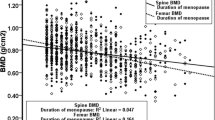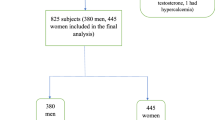Abstract
Summary
We measured bone mineral density (BMD) in Kuwaiti women residents in the largest province of Kuwait state to highlight the BMD changes with each age, in particular when they reach the postmenopausal stage. Healthy Kuwaiti females between the ages of 10 and 89 years, who were residents in the largest province of Kuwait, were included in the study. After measurements of their height and weight, their bone mineral density of L2–L4 lumbar spine and femur (neck and total) was measured using dual-energy X-ray absorptiometry. Out of the studied 903 female subjects, 811 fulfilled the inclusion criteria. Their mean ± SEM age and body mass index (BMI) were respectively 47 ± 1 years and 30.8 ± 0.2 kg/m2. Out of these 811 subjects, 454 were postmenopausal, and their age and BMI were 55.0 ± 0.3 years and 32.0 ± 0.3 kg/m2, respectively. We have demonstrated that osteoporotic BMD of the spine and femur neck occurred in 20.2 and 12.5 % of postmenopausal Kuwaiti females, whereas osteopenic BMD of the spine and femur neck was observed at a frequency of 35.4 and 42.8 % of women, respectively. When the subjects were subdivided as per BMI, it was notable that overweight and obese had significantly higher BMD than normal weight postmenopausal women. BMD of the spine, femur neck, and femur total demonstrated significant positive correlations with body weight and BMI, whereas they demonstrated significant negative correlations with age. Low BMD of the femur neck and spine, reflected by the combination of osteopenia and osteoporosis, seemed to occur in more than half (55.3–55.6 %) of postmenopausal Kuwaiti women.
Objectives
Most of the studies on assessment of prevalence of low bone mass were focused in Caucasian population. Data on subjects of the Mediterranean area are limited. We measured bone mineral density (BMD) in Kuwaiti women residents in the largest province of Kuwait state to highlight the BMD changes with each age, in particular when they reach the postmenopausal stage.
Subjects and methods
Kuwaiti female subjects of different age groups between 10 and 89 years, who were residents in the largest province of Kuwait (Hawalli), were included in the study. They were included if they had been healthy over the last 12 months, had no past history of bone disease, and are not taking any prescription medication that may affect bone density. Their bone mineral density of L2–L4 lumbar spine and femur (neck and total) was measured using dual-energy X-ray absorptiometry.
Results
Out of the studied 903 female subjects, 811 fulfilled the inclusion criteria and were included in the study. Their mean ± SEM age and body mass index (BMI) were respectively 47 ± 1 years and 30.8 ± 0.2 kg/m2. Out of these 811 subjects, 454 were postmenopausal, and their age and BMI were 55.0 ± 0.3 years and 32.0 ± 0.3 kg/m2, respectively. We have demonstrated that osteoporotic BMD of the spine and femur neck occurred in 20.2 and 12.5 % of postmenopausal Kuwaiti females, respectively, whereas osteopenic BMD of the spine and femur neck was observed at a frequency of 35.4 and 42.8 % of women. When subjects were subdivided as per BMI, it was notable that overweight and obese postmenopausal women had significantly higher BMD of lumbar spine, femur neck, and femur total than normal weight postmenopausal women. Bone mineral densities of the spine, femur neck, and femur total demonstrated significant positive correlations with body weight and BMI, whereas they demonstrated significant negative correlations with age.
Conclusion
Low BMD of the femur neck and spine, reflected by the combination of osteopenia and osteoporosis, seemed to occur in more than half (55.3–55.6 %) of postmenopausal Kuwaiti women residents at the largest province of Kuwait.



Similar content being viewed by others
References
Lane NE (2006) Epidemiology, etiology and diagnosis of osteoporosis. Am J Obstet Gynecol 194:S311–S315
Johnell O, Kanis JA (2004) An estimate of the worldwide prevalence, mortality and disability associated with hip fracture. Osteoporosis Int 15:897–902
Gourlay ML, Brown SA (2004) Clinical considerations in premenopausal osteoporosis. Arch Intern Med 164:603–614
Melton LJ (1995) How many women have osteoporosis now? J Bone Miner Res 10(2):175–177
El-Hajj Fuleihan G, Adib G, Nauroy L (2011) The Middle East and Africa regional audit: Epidemiology, cost and burden of osteoporosis. IOF website accessed on 2012
El-Desouki M (1995) Bone mineral density of the spine and femur in the normal Saudi population. Saudi Med J 16:30–35
Bhudhikanok GS, Wng MC, Ecket K et al (1996) Differences in bone mineral in young Asian and Caucasian Americans may reflect differences in bone size. J Bone Res 11:1545–1556
Ghannam NN, Hammami MM, Bakheet SM et al (1999) Bone mineral density of the spine and femur in healthy Saudi females: relation to vitamin D status, pregnancy and lactation. Calcif Tissue Int 65:23–28
Bachrach LK, Hastie T, Wang MC et al (1999) Bone mineral acquisition in healthy Asian, Hispanic, Black and Caucasian youth: a longitudinal study. J Clin Endocrinol Metab 84:4702–4712
Maalouf G, Salem J, Sandid M et al (2000) Bone mineral density of the Lebanese reference population. Osteoporos Int 11:756–764
Deleze’ M, Cons-Molina F, Villa AR et al (2000) Geographic differences in bone mineral density of Mexico women. Osteoporos Int 11:562–569
Mahussain S, Badr H, Al-Zaabi K, Mohammad M, Alnafisi N (2006) Bone mineral density in healthy Kuwaiti women. Arch Osteoporos 1:51–57
Wu XP, Liao EY, Huang G et al (2003) A comparison study of reference curves of bone mineral density at different skeletal sites in native Chinese, Japanese and American Caucasian women. Calcif Tissue Int 73:122–132
Maalouf G, Gannagé-Yared MH, Ezzedine J et al (2007) Middle East and North Africa consensus on osteoporosis. J Musculoskelet Neuronal Interact 7(2):131–143
Larijani B (2004) An overview of osteoporosis in Iran. 1st International Osteoporosis Seminar in Iran. Teheran, Iran
El-Hajj Fuleihan G, Baddoura R, Awada H, Salam N, Salamoun M, Risk P (2002) Low peak bone mineral density in healthy Lebanese subjects. Bone 31:520–528
Ardawi MS, Maimany AA, Bahksh TM, Nasrat HA, Millaat WA, Al-Raddadi RM (2005) Bone mineral density of the spine and femur in healthy Saudi Arabs. Osteoporos Int 16:43–55
El-Dessouki MI (2003) Osteoporosis in postmenopausal Saudi women using X-ray bone densitometry. Saudi Med J 24:935–936
Hammoudeh M, Al-Khayarin M, Zirie M, Bener A (2005) Bone density measured by dual energy X-ray absorptiometry in Qatari women. Maturitas 52:319–327
World Health Organization (1998) Preventing and managing the global epidemic: report of the WHO consultation on obesity. WHO, Geneva
World Health Organization (1994) Assessment of fracture risk and its application to screening for postmenopausal osteoporosis. Report 843. World Health Organization, Geneva
El-Dessouki MI (1999) Osteoporosis in postmenopausal Saudi women using dual X-ray bone densitometry. Saudi Med J 20(4):283–286
Alsawy S (2009) Edentulism as a predictor of osteoporosis among postmenopausal Bahraini women. International Society for Clinical Densitometry-IOF joint meeting. Abstract book Poster 141:31
Taha M (2011) Prevalence of osteoporosis in Middle East systemic literature review, 10th ECOO, April 2011, http://www.scribd.com/doc/53103901/Osteopoorosis-Cairo-April-2011-v1. Accessed Apr 2011
Premaor MO, Pilbrow L, Tonkin C, Parker RA, Compston J (2010) Obesity and fractures in postmenopausal women. J Bone Miner Res 25(2):292–297
Nitzan-Kaluski D, Chinich A, Ifrah A, Merom D, Green MS (2003) Correlates of osteoporosis among Jewish and Arab women aged 45–74 in Israel: national women’s health interview survey. J Gend Specif Med 6(1):17–23
Felson DT, Zhang Y, Hannan MT, Anderson JJ (1993) Effects of weight and body mass index on bone mineral density in men and women: the Framingham study. J Bone Miner Res 8(5):567–573
Nguyen TV, Center JR, Eisman JA (2000) Osteoporosis in elderly men and women: effects of dietary calcium, physical activity, and body mass index. J Bone Miner Res 15(2):322–331
Baheiraei A, Pocock NA, Eisman JA, Nguyen ND, Nguyen TV (2005) Bone mineral density, body mass index and cigarette smoking among Iranian women: implications for prevention. BMC Musculoskelet Disord 6:34. doi:10.1186/1471-2474-6-34
Nielson CM, Srikanth P, Orwoll ES (2012) Obesity and fracture in men and women: an epidemiologic perspective. J Bone Miner Res 27(1):1–10
Riggs BL (1990) Causes of age-related bone loss and fractures. In: DeLuca HF, Mazess R (eds) Osteoporosis, physiological basis, assessment, and treatment. Elsevier, New York, pp 7–16
Liggett N, Reid D (2000) The incidence, epidemiology and aetiology of osteoporosis. Hosp Pharm 7(3):62–68
Ahlborg HG, Johnell O, Turner CH, Rannevik G, Karlsson MK (2003) Bone loss and bone size after menopause. N Eng J Med 349:327–334
Baroncelli G, Bereket A, El Kholy M et al (2008) Rickets in the Middle East: role of environment and genetic predisposition. J Clin Endocrinol Metab 93:1743–1750
Kimball S, Fuleihan GEH, Vieth R (2008) Vitamin D: a growing perspective. Crit Rev Clin Lab Sci 45:339–414
Molla AM, Al Badawi M, Hammoud MS et al (2005) Vitamin D status of mothers and their neonates in Kuwait. Pediatr Int 47(6):649–652
El Sonbaty MR, AbdulGhaffar NU (1996) Vitamin D deficiency in veiled Kuwaiti women. Eur J Clin Nutr 50:315–318
Memon A, Pospula WM, Tantawy AY, Abdul-Ghafar S, Suresh A, Al-Rowaih A (1998) Incidence of hip fracture in Kuwait. Int J Epidemiol 27:860–865
Conflicts of interest
None.
Author information
Authors and Affiliations
Corresponding author
Rights and permissions
About this article
Cite this article
Al-Shoumer, K.A.S., Nair, V. Prevalence of low bone mass in postmenopausal Kuwaiti women residents in the largest province of Kuwait. Arch Osteoporos 7, 147–153 (2012). https://doi.org/10.1007/s11657-012-0092-1
Received:
Accepted:
Published:
Issue Date:
DOI: https://doi.org/10.1007/s11657-012-0092-1




